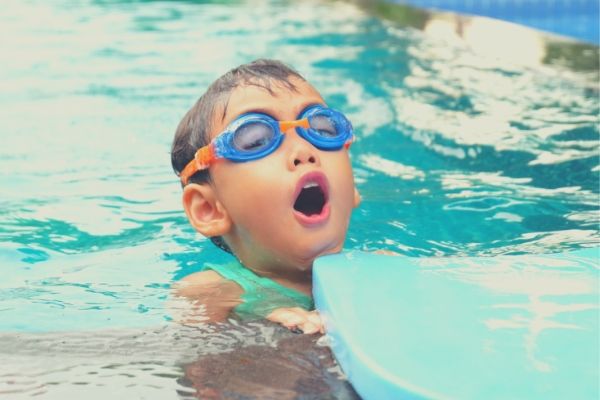Swimming independence cannot be attained without proper breath control. Adult and competitive swimmers talk about breathing techniques that help them excel, but for children, breath control is about just a few key concepts, none of which are related to performance or competition. Rather, breath control for kids is about safety and skill development.
For a child to demonstrate breath control, that child must be able to hold their breath while their face is under the water and take breaths once their face comes out of the water. This may sound easy to those of us who have been swimming for our whole lives, but it actually takes quite a bit of practice for kids to get the hang of this!
In this lesson, you’ll learn how to introduce your child to facial submersions and beginner breath control games. Remember back to earlier lessons when we discussed boiling down learning to swim into it’s simple parts, 1) comfort, 2) propulsion and 3) breath control? Well, facial submersion is a cornerstone of all 3.
It takes some guts to put your face in the water for the first time, there’s no air down there and kids intuitively know it. So, how easily and confidently your child puts his or her face in the water is a great indicator of their level of comfort.
In Lesson #4 on teaching your child how to doggy paddle, we covered how as your child progresses from a vertical to a horizontal body position forward propulsion gets much easier. Think about competitive swimmers you’ve seen swim before, they are stretched out across the water horizontally, right? That’s because it’s much more efficient and energy saving to swim this way. When your child puts his or her face in the water, it’ll make it easier for their feet to come up to the surface and for energy to be spent moving forward where they want to go.
For a child to demonstrate breath control, that child must be able to hold their breath while their face is under the water and take breaths once their face comes out of the water. This may sound easy to those of us who have been swimming for our whole lives, but it actually takes quite a bit of practice for kids to get the hang of this!
Here are 3 techniques that can be used to develop proper breathing technique and control in young children:
1. Teach your child to put their face under the water.
The best way to do this is by modeling the actions you want to see your child do and to make it as fun as possible! Here’s how we teach beginner face submersion at our swim school:
- Start with your child seated on the pool steps with water at about chest height
- We like to make this activity an engaging game by pretending to be alligators or dolphins together with our students - because they eat fish and fish, of course, live underwater
- Make eye contact with your child and then take an over-emphasized big breath in and shut your lips
- Look down and face the water, then dip-in your entire face, lips, nose and eyes at the same time. If you’re playing the game well, you’ll come up and pretend to gobble up the fish you just “caught”by going underwater
- Encourage your child to give it a try.
Mimicry is one of the best ways to get your child to try something new, especially if you make it look like a lot of fun! Never force your child to do more than he or she is ready for. If this is your first few times giving breath control a shot and your child is a bit scared - consider it a win (and celebrate it) if your child puts his or her lips, nose or forehead in. Practice this game 1-5 times a lesson.
Once your child can catch 1-fish, it’s time to catch 3… and then 5!
Catching 1-fish, or simply dipping the face in the water is step #1 to developing breath control. Once your child is comfortably dipping his or her entire face in the water, it’s time to increase the difficulty of the exercise. We’ll show you how to keep it fun!
If you child liked pretending to be an alligator or a dolphin, keep playing that game. If not, use your imagination and come up with a game your child does like - or better yet, have them come up with a game!
Start with mimicry again! At our swim school we find great success by having your child be your “coach” while you go underwater and count out loud to 3 seconds. Go underwater and have our child count, 1-fish, 2-fish, 3-fish… then pop up and gobble up the fish that you just caught. To get deeper into imagination land, aka fun land, we like to name the kinds of fish we got as ice cream flavors or other odd-flavors. For example, an orange fish, a strawberry fish and a chocolate fish.
Have your kid try it and be sure to count out loud for them! One he or she can stay under for a 3-count, move up to 5 seconds.
Now it’s time to add forward propulsion to breath control
Now that your child has grown comfortable and mastered passive breath control, it’s time to add in some movement and forward propulsion. Before you can start removing floatation aids from the progressive training vest, your child will need to learn how to hold his or her breath while kicking and paddle swimming.
We’ll start by adding breath control to the front kick, let’s go back to using the pool noodle.
- Start your child seated on the pool stairs with water at about chest height
- Have your child grab the noodle with their hands shoulder-width apart
- Instruct your child to hold the noodle out in front of them with straight arms - this will create a large enough space for your child to put his or her face in the water while kicking
- You can continue to practice “catching fish,” but this time pretend that the fish are swimming around and your child needs to kick to go catch them
- As your child pushes from the wall, instruct them to put their face in
- Help your child with breath control by counting aloud, “1, 2, 3, breathe!” At this point, your child should come up for air.
- Repeat this 3-4 times.
Once your child can front kick with breath control - we’ll add it to the doggy paddle exercise too.
To do this simply repeat the same game as you did in the kicking exercise above, but with doggy paddle instead. Your child should still use the proper technique we covered in Lesson #4, but this time perform the exercise with his or her face in the water. The breath pattern is still “1, 2, 3 breathe.” Be sure to count out loud so your child can hear you and start to naturally use that breath pattern on his or her own.
Are you ready for what comes next?
While you’re here, check out our FUNdamentals classes, held here in Atlanta for children ages 2.5-8 years old! We would love to see you here! Let us know what questions we can answer and how we can help you teach your child how to be a great swimmer!





